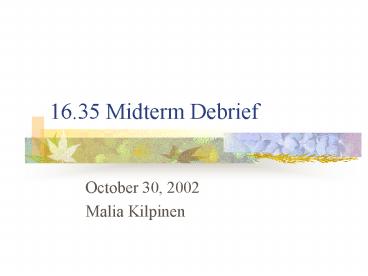16.35 Midterm Debrief - PowerPoint PPT Presentation
Title:
16.35 Midterm Debrief
Description:
Audi, BMW: BeepPointer; Audi : new Beep; BMW : new Beep; ... BMW points to Audi's memory location. BMW.all := Audi.all; BMW holds same values as Audi ... – PowerPoint PPT presentation
Number of Views:40
Avg rating:3.0/5.0
Title: 16.35 Midterm Debrief
1
16.35 Midterm Debrief
- October 30, 2002
- Malia Kilpinen
2
Question 1
- What are process models? Compare and contrast
the spiral model of development with another
model of your choice. (15p)
3
Solution 1 - Process Model
- A software process model is an abstract
representation of a process. It presents a
description of a process from some particular
perspective.
4
Solution 1 - Spiral Model
- Process is represented as a spiral rather than as
a sequence of activities with backtracking. - Each loop in the spiral represents a phase in the
process. - No fixed phases such as specification or design
-loops in the spiral are chosen depending on what
is required. - Risks are explicitly assessed and resolved
throughout the process.
5
Solution 1 - Spiral Model
- Objective Setting
- Risk assessment and reduction
- Development and validation
- Planning
- ltltThere is a picture in Van Vliet pg 62.gtgt
6
Question 2
- Who are the expected readers of a requirement
specification and what properties do they want
the specification to have? (5p)
7
Solution 2
- Users and the customer (in case of custom-made
product) - want readability, completeness, consistency,
correctness, may serve as a contract
(testability) - Designers
- readability, consistency, non-ambiguity,
traceability - Testers
- testability
- Maintenance staff
- completeness, traceability
8
Question 3
- Consider the following piece of program, which
assumes a large integer C and an array A(0..C).
It is intended to assign the maximum of A to the
variable max. - max A(0)
- i 1
- while i lt C loop
- i i1
- if A(i) gt max
- then max A(i)
- end if
- -- max is the maximum of A(0..i)
- end loop
9
Question 3 (cont.)
- a) Show what steps must be taken to find test
cases for coverage testing, using this program as
an example. Show the distinction between
node-coverage and branch-coverage. (5p) - b) What method(s) of verification are both
practical and would likely reveal the error? Note
that C is large. Motivate your answer. (3p)
10
Solution 3 - Part a
- 1) draw flow-chart, identify nodes and branches
- 2) find a collection of paths that visits all
nodes/branches - 3) find input data that makes the program follow
each path (if it turns out that there is no such
data, the path is infeasible, go back to 2 and
replace it by other paths) - in this case, the difference is that branch
coverage requires that the test A(i)gtmax is true
sometimes, and false sometimes. For node
coverage, it may always be true. In any case,
only one test is necessary. Say C3, and
A5,2,3,6
11
Solution 3 - Part b
- The error is that A(1) is never checked. A
statistical test has probability 1/C to detect
this. - From a) we can see that it is easy to achieve
branch coverage and yet miss the error. - A boundary value test might detect it, if you
have a rather broad definition of boundary.
Such a definition will soon be unworkable.
Inspection has a good chance. - (Formal verification, that can be done mostly
automatically when loop invariants are provided,
is another candidate.)
12
Question 4
- Describe the architectures repository model and
client-server. Compare their pros and cons. (6p)
13
Solution 4 - Repository
- Advantages
- Efficient way to share large amounts of data
- Sub-systems need not be concerned with how data
is produced - Centralized management e.g. backup, security,
etc. - Disadvantages
- Sub-systems must agree on a repository data
model. Inevitably a compromise - Data evolution is difficult and expensive
- No scope for specific management policies
- Difficult to distribute efficiently
14
Solution 4 - Client Server
- Advantages
- Distribution of data is straightforward
- Makes effective use of networked systems. May
require cheaper hardware - Easy to add new servers or upgrade existing
servers - Disadvantages
- No shared data model so sub-systems use different
data organisation. data interchange may be
inefficient - Redundant management in each server
- No central register of names and services - it
may be hard to find out what servers and services
are available
15
Question 20
- Cow-moon Ada code trace problem. (2p)
16
Solution 20
- Output is
- 3 14
- Moo! Moo! Moo! Moo!
- 7 6
17
Question 21
- What does it mean to declare a variable as
private? When would you declare a variable as
private? (1p)
18
Question 22
- Write a program to calculate the cube of a
user-inputted integer. Your program should
include error checking. (6p)
19
Solution 22
- Should use Skip_Line function in error checking.
- Simplified version of problem set 2.
20
Question 23
- Assume that a record type Beep has been defined.
The following pointers are then declared (1p) - type BeepPointer is access Beep
- Audi, BMW BeepPointer
- Audi new Beep
- BMW new Beep
- What is the difference between the following
commands? - BMW Audi
- BMW.all Audi.all
21
Solution 23
- Discussed in Ada Compendium.
- BMW Audi
- BMW points to Audis memory location
- BMW.all Audi.all
- BMW holds same values as Audi































